The Best Road Running Shoes of Winter 2024
This article originally appeared on Outside
There is no such thing as the single best running shoe for everyone. Every runner's body, gait, speed, experience, and ride preferences are different, so every runner will interact differently with each running shoe. The shoe that your best friend or your sister-in-law loves may be uncomfortable for you and make running feel slow, sluggish, or even painful. Finding the perfect pair of running shoes is a seriously personal affair.
While we can't tell you the definitive best shoe, we can steer you toward models that have impressed a variety of testers with their comfort, support, traction, protection, and ride, and tell you where they excel. From this list you will need to select which shoes best complement and enhance your running stride and experience.
The Winners At-A-Glance
The Best Road Running Shoes of Winter 2024
Best Carbon-Fiber-Fueled Speed Trainer: Asics Magic Speed 3
Most Versatile Cushioned Trainer: Saucony Kinvara Pro
Best Distance Trainer: Adidas Adizero Boston 12
Best for Cushioned Everyday Runs: Skechers GO RUN Ride 11
Best Plush Stability: Asics GEL-Kayano 30
Best Lightweight Daily Trainer: Brooks Hyperion GTS
Best Recovery Shoe: Nike InfinityRN 4
The Best Road Running Shoes of Summer 2023
Best Daily Trainer: Tracksmith Eliot Runner
Best for Plush Stability: Puma ForeverRun Nitro
Best for Carbon-Fiber-Fueled Speed: Hoka Rocket X2
Best Combo of Cushioning and Connection: Topo Cyclone 2
Best for Smooth Cruising: Adidas Ultraboost Light
Best for Comfort Junkies: Asics Gel-Nimbus 25
Best for Longer Races: Saucony Endorphin Elite
Best for Nimble Versatility: Brooks Levitate 6
Most Forgiving: Nike Invincible 3
Best Cushy Uptempo Shoe: On Cloudsurfer
The Reviews: The Best Road Running Shoes of Winter 2024
Best Carbon-Fiber-Fueled Speed Trainer: Asics Magic Speed 3 ($160)
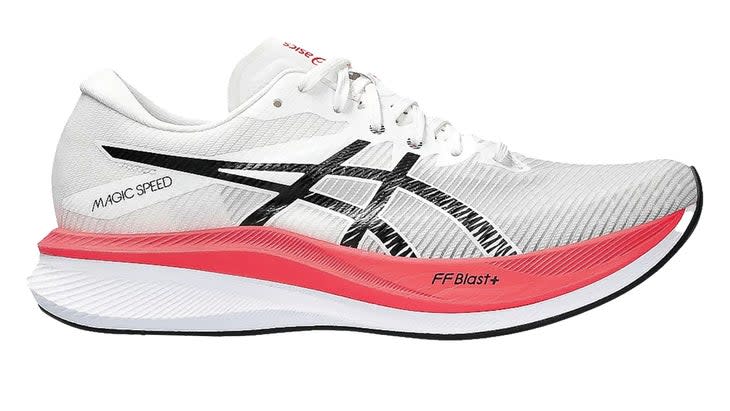
Weight: 7.7 oz (men's); 6.5 oz (women's)
Stack Height: 36-29mm (men's); 35-27mm (women's)
Drop: 7 mm
Sizing: Men's 6-15; Women's: 5-12
Strengths: New bouncy, snappy midsole, breathable mesh upper
Weaknesses: Not as adaptable to different strides as some super trainers
The Asics Magic Speed 3 proves that low cost and high performance aren't mutually exclusive. Priced nearly a hundred dollars less than many carbon-fiber super shoes, these are "the best bang-for-the-buck 5k-to-half marathon racing or speed workout shoe on the market," said one tester. Asics swapped the carbon/TPU blend plate in the Magic Speed 2 for a full-length carbon fiber plate that's noticeably more snappy and forward-propelling. That, coupled with a soft and responsive double layer of Asics' top EVA-based midsole foam, results in a "light and bouncy ride" that "inspires speed," noted one tester, while not feeling overly bouncy or unstable. Complementing the magic in the midsole is the same form-fitting, airy, lightweight mesh upper material seen on the brand's top-tier, carbon-fiber, marathon-racing models.
Most Versatile Cushioned Trainer: Saucony Kinvara Pro ($180)
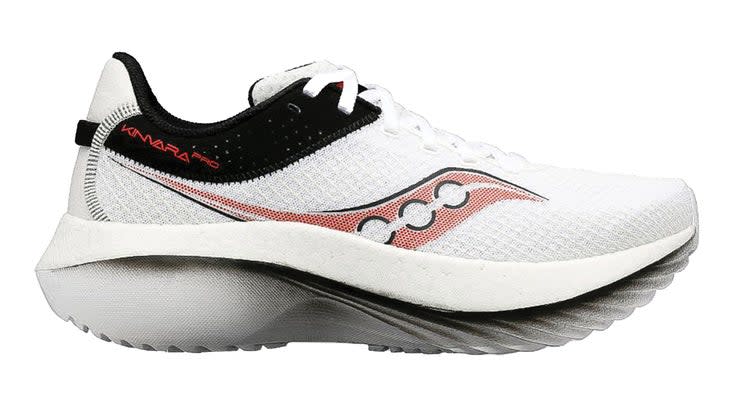
Weight: 9.5 oz (men's), 8.5 oz (women's)
Stack Height: 42-34mm
Drop: 8mm
Sizing: Men's 7-15; Women's 5-12
Strengths: Combines cush, support, and performance in one package
Weaknesses: Lack of durable rubber on the outsole
While the Kinvara has meant minimalist speed for over a decade, this "Pro" version adds oodles of cushioning and a teardrop-shaped (tapered at the heel) 3/4 -length carbon-fiber plate that delivers soft landings and extra snap. The cush comes from a layer of Saucony's resilient Pebax superfoam over a firmer, more stable slab of an EVA-blend that doubles as the outsole, all topped by a responsive, TPU-based insole. The combination results in a fun, versatile, mega-cushy-while-still-slightly-stable shoe that can handle anything from easy recovery runs to long tempo efforts. Testers raved at the "responsive, snappy, poppy" ride that, one said, "allowed me to run faster with less effort." One tester felt that the shoe not only did a great job of absorbing impact, but that it transferred the load of each step toward forward propulsion.
We love the combination of comfort and performance of the Kinvara Pro, proving you don't have to sacrifice one for the other. The ride is springy, energetic, and downright lively. Suede-like (it's vegan) paneling around the heel collar and a stretchy, slightly padded tongue add to the deluxe feel.
Best Distance Trainer: Adidas Adizero Boston 12 ($160)
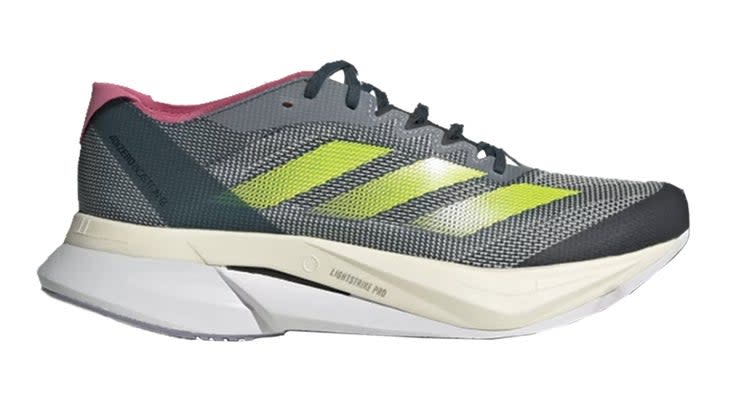
Weight: 9.5 oz (men's), 8 oz (women's)
Stack Height: 37-30.5mm
Drop: 6.5mm
Sizing: Men's 4-15; Women's 5-12
Strengths: Grounded feel with extra pop, durable traction
Weaknesses: Upper can feel firm around the heel collar
Unlike many plated super-trainers that produce a hyper-cushy turbo boost, the Adizero Boston 12 allows a stable, connected ground-feel, delivering a more traditional running shoe vibe with a little extra pop--which some testers found preferable when putting in training miles. The shoe's smooth roll comes from curved, glass-fiber-infused rods that parallel the foot's metatarsal bones from heel to toes, sandwiched between a thick top layer of Adidas's premium, bouncy, TPE-based foam (tuned softer than previous versions) and a bottom layer of a more-stable EVA blend. "I felt light on my feet and able to move and react quickly wearing these shoes," said a tester.
The mesh upper is minimal and racy, which made us feel like going fast, and the Continental rubber outsole provides great traction for quick cornering and secure footing even on wet roads. This is a fun shoe to push the pace in, and a solid training partner for marathoners. Note: The fit is wide in the forefoot, leaving some testers craving a more secure foothold.
Best For Cushioned Everyday Runs: Skechers GO RUN Ride 11 ($125)
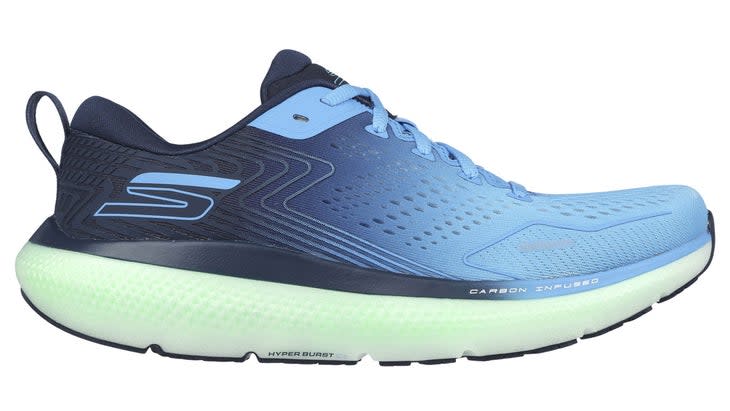
Weight: 9.9 oz (men's), 7.6 oz (women's)
Stack Height: 38-32mm
Drop: 6 mm
Sizing: Men's 7-14; Women's 5-11
Strengths: Responsive midsole, comfortable upper, great price point
Weaknesses: Lacks breathability
If you think Skechers is predominantly a walking and lifestyle brand, think again. Since the brand introduced the Hyperburst midsole in 2018, we’ve praised any running shoe featuring the ultralight, responsive foam. The newest formulation of the supercritical, gas-infused EVA foam found in the GO RUN Ride 11 is softer, and was "as well-cushioned and lively as any running shoe I've tried," according to one tester. Embedded in the forefoot is a carbon-infused, H-shaped plate that's not too stiff, allowing for a more natural forefoot flex while enhancing stability and speeding the roll off the toe. "It allows me to run freely, using my foot as it was meant to be used," noted another tester.
Despite being advertised as a neutral everyday trainer, we applaud its versatility and ability to perform at any pace. From recovery to tempo runs, the GO RUN Ride 11 is remarkably smooth and bouncy. "I feel like I could run all day in them," one tester raved. The plush, well-padded engineered mesh upper is one of the more comfortable uppers we tested, but we found it does lack adequate breathability when it’s hot. Bottom line: A modern, comfortable, versatile everyday trainer at a bargain price.
Best Plush Stability: Asics GEL-Kayano 30 ($160)
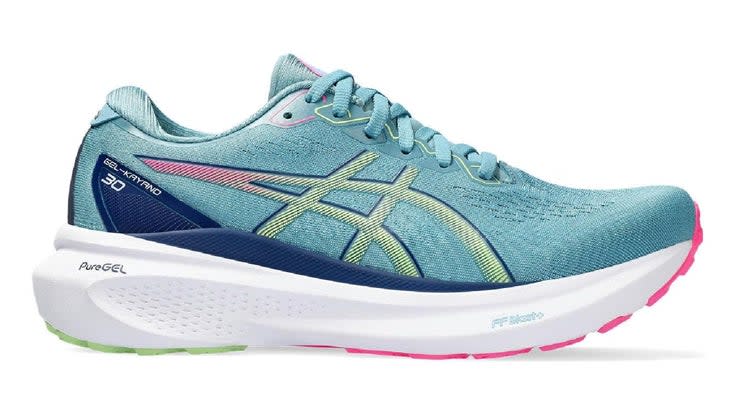
Weight: 10.6 oz (men's), 9.2 oz (women's)
Stack Height: 40--30mm (men's); 39-29mm (women's
Drop: 10 mm
Sizing: Men's 6-16; Women's 5-13
Strengths: Well-cushioned, smooth rolling, stable without being firm or stiff
Weaknesses: Heavy
As running shoe brands begin to rethink the traditional strategies of using stiff midsoles and firm posts under the arch to control foot movement in stability shoes, no other flagship shoe has embraced this departure more than Asics GEL-Kayano 30. Every single tester, including our most prominent critic of stability shoes, applauded the now softer, newly refined model.
Asics created plush stability in the GEL-Kayano 30 by means of a wider midsole with an increased heel bevel, a flared sole under the forefoot, and, most surprisingly, a softer, high-energy foam under the arch where we're used to finding a firm medial post. Rather than attempting to block rotational movement, Asics says the bouncy insert, in combination with the shoes' geometry, is designed to reduce the time at peak pronation and gently guide an over-rotating foot back into a more neutral position as it transitions from heel to toe-off. Combined, these elements "delivered a smooth, comfortable ride that is stable without any hint of control," said a neutral tester.
The stack height is also four millimeters higher than the previous GEL-Kayano, and the gel insert is 65 percent softer. The result is a shoe with softer cushioning that's more "protective, responsive, and smoother," as one tester described. Asics also added a steeper toe spring to help maintain a smooth toe-off from the thicker, more voluminous midsole. The plush persona continues throughout the engineered mesh upper that's simple and heavily padded around the heel counter.
Best Recovery Shoe: Nike InfinityRN 4 ($160)
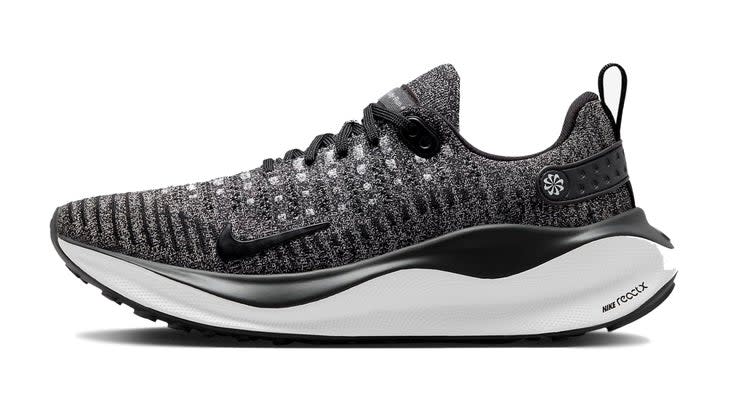
Weight: 12.5 oz (men's), 9.9 oz (women's)
Stack Height: 39-30mm
Drop: 9mm
Sizing: Men's 6-15; Women's 5-12
Strengths: Plush, comfortable platform that works for all gaits
Weaknesses: Laces and tongue can dig into narrow feet when cinched
Since its inception, the InfinityRN has aimed to ward off injury with its soft-but-responsive foam, wide base, and unique heel shape with a deep groove on the lateral (outside) edge, encouraging a fluid landing and smooth transition through the stride. This fourth iteration maintains those characteristics, while getting an even wider base and losing its firm heel clip. While there is scant evidence linking any injury with running shoes, testers universally reported the InfinityRN 4 didn't make any aches worse. In fact, one found that this shoe helped relieve her achy knee. Our test team also unanimously appreciated the InfinityRN 4's comfortable ride, which made us want to run in the shoe regardless of its injury-prevention powers.
The latest InfinityRN uses Nike's ReactX foam, which is cushier and springier than the original Nike React. A more energy-efficient injection-molding process makes the new foam more environmentally friendly, too. The new foam is not as explosive as Nike's Pebax-based ZoomX, but delivers a smoother, more stable feel underfoot, and testers confirmed it does seem livelier than the original React blend. The knit upper, which is soft and stretchy, is also new, and fits more like a sock than a traditional running shoe. Said a tester: "It checks off every box for me in a good road shoe: comfortable, lightweight, well-cushioned, and supportive to handle the miles."
Best Lightweight Daily Trainer: Brooks Hyperion and Hyperion GTS ($140)
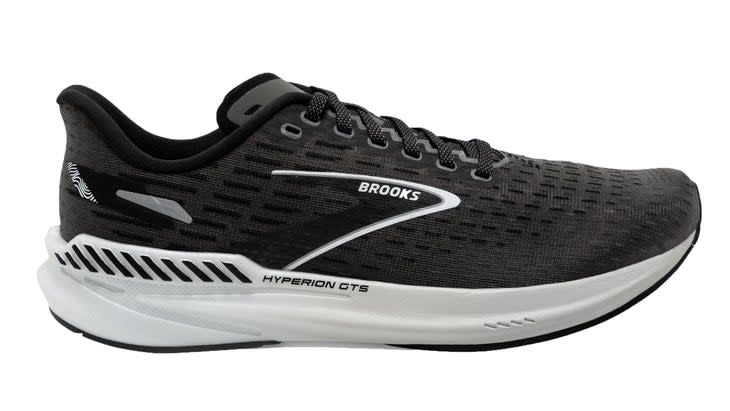
Weight: 7.6 oz (men's), 6.8 oz (women's); GTS: 7.9 oz (men's), 7.3 oz (women's)
Stack Height: 28mm-20mm
Drop: 8mm
Sizing: Men's 7-15; Women's 5-12
Strengths: Lightweight, low-profile, agile-feeling, breathable
Weaknesses: Slightly firm, more ground feel than some prefer
Women's Hyperion Men's Hyperion
Women's Hyperion GTS Men's Hyperion GTS
We loved both the Brooks Hyperion and Hyperion GTS for their lightweight comfort and springy, nitrogen-infused cushioning that one tester described as "fun and fast." The only difference between the two shoes is that the GTS version features segments of firmer foam on top of the midsole along both sides of the heel--what Brooks called "GuideRails"--to help reduce rotation for runners whose stride strays excessively inward or outward, especially towards the end of their run as a result of fatigue. Both versions feature a lightly-padded, flexible, and super-breathable upper, which ranked high among hot-footed testers, but some felt chilly in winter conditions.
These shoes are ideal for any runner looking for a daily trainer or racer that gives them some feel for the ground. In an era of massive amounts of cushioning that can sometimes make us feel like we're running on cushy platforms, the Hyperion and Hyperion GTS offer a lower-riding, more connected running experience without compromising rebound and comfort.
The Best Road Running Shoes of Summer 2023
Best Daily Trainer: Tracksmith Eliot Runner ($198)
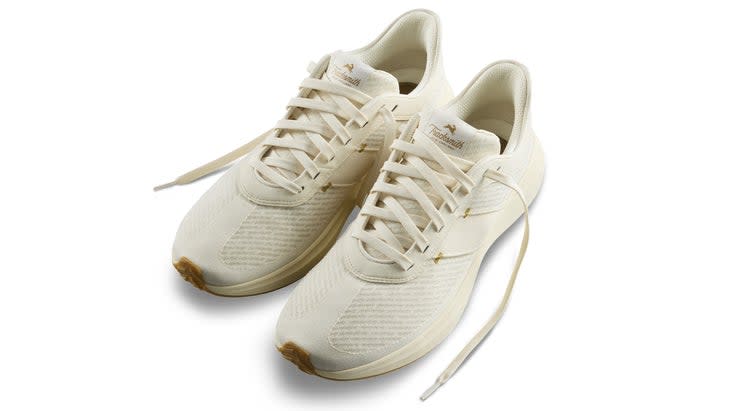
Weight: 9.2 oz (men's), 8.0 oz (women's).
Stack Height: 33.5-24.5mm
Drop: 9 mm
Sizes: Unisex shoe, M4/W5.5-M13/W14.5
Strengths: Good looks, immediate comfort, wide versatility
Weaknesses: Can feel a tad soft for fast efforts
Earning the distinction of "Best Daily Trainer" means this shoe cushions plenty for long runs, feels peppy and spry enough for tempo efforts, inspires quick quarter-mile efforts on the track, and can be worn casually on the daily. This trainer does it all.
Underfoot comfort and cush comes from a combination of a soft, super-thick (three times the norm) sockliner layered over a slightly denser midsole, both made of Pebax--the premier shock-absorbing compound of the hour, usually found in marathon-racing supershoes. The sockliner aims to mimic the feel of running on fall leaves or soft dirt (and does), while the firmer midsole is designed to compress just enough to encourage underfoot pop (and does). The fit leans low-volume from top to bottom, adding to a sleek feel, while a secure heel hold tapers out to a slightly wider toe box.
The engineered mesh upper sports soft and retro-stylish synthetic suede around the heel collar and lacing eyelets, and achieves structure with a simple sash at midfoot. This is a comfortable, capable, and great-looking shoe that we're mildly obsessed with.
Best for Plush Stability: Puma ForeverRun Nitro ($150)
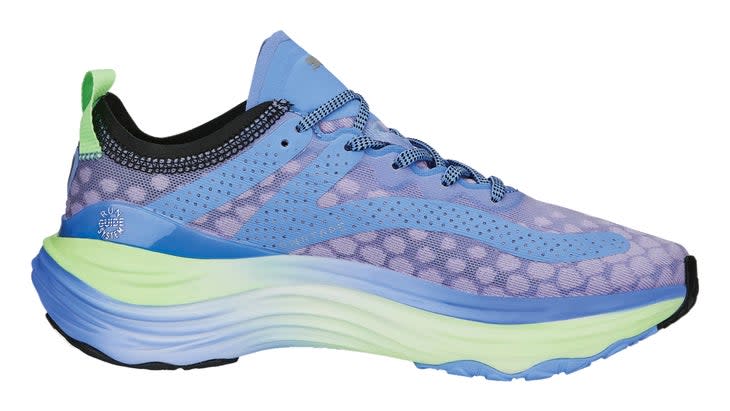
Weight: 9.7 oz (men's), 7.9 oz (women's)
Stack Height: 36-26 mm
Drop: 10 mm
Sizes: 7-14 (men’s), 5.5-11 (women’s)
Strengths: Wide, stable platform with springy ride; secure, supportive upper
Weaknesses: Heel-toe drop felt high to some
It's rare to find a stability shoe that feels like a soft, plush, daily trainer--and also puts pep in your stride. With a fat midsole stacked with Puma's nitrogen-infused, rubberized compound that absorbs and rebounds with aplomb, the ForeverRun Nitro is all that. The shoe creates subtle stability with a wide platform underfoot and a firmer-density foam frame topped by an external TPU heel clip, plus a sockliner designed to enhance forefoot alignment. "This shoe delivers a smooth ride that made me feel supported without ever getting in the way," said one tester, who used them for everything from recovery days to tempo runs.
The ForeverRun Nitro also creates a great feeling of control thanks to excellent fit and traction. A secure heel hold gives way to a roomy toebox, while the tongue perfectly rides the line of minimal and cushy so that you don't cause pressure on the top of the foot when you crank down the laces. The outsole's traction, and slight flare of both midsole and outsole under the big toe, gave us great traction and security even on wet pavement.
Best for Carbon-Fiber-Fueled Speed: Hoka Rocket X 2 ($250)
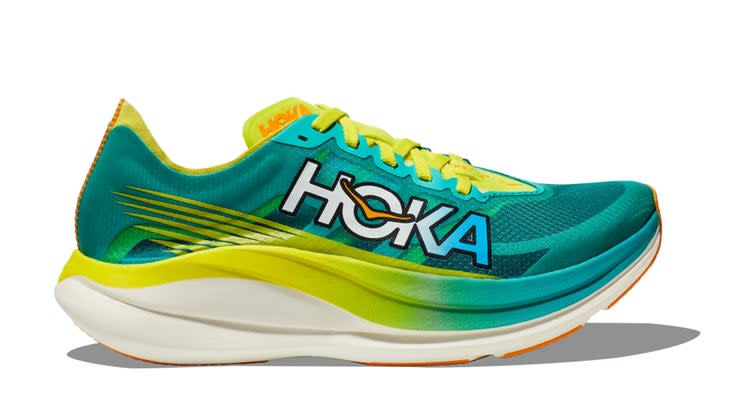
Weight: 8.3 oz (men's), 6.7 oz (women's)
Stack Height: 36-31 mm--not including insole
Drop: 5 mm
Sizes: 5-14 (men's), 6-15 (women's)
Strengths: Phenomenally bouncy and explosive; comfortable, stretchy upper
Weaknesses: Heavy relative to other supershoe racers
After three years of being all but absent in the carbon-fiber supershoe game, Hoka finally lined up to compete with a top-to-bottom redesign of their first carbon-fiber racer, the Rocket X. The new tall, squishy, and energetic Rocket X 2 is nothing like the firm, low-profile original. Thanks to an all-new midsole using dual-density PEBA-based foam, the resulting ride is bouncy, explosive, and forward-propelling, one of the peppiest midsoles we've tested. Running in the Rocket X 2 felt like we were effortlessly bouncing from foot to foot. A steep, late rocker under the forefoot gives the Rocket X 2 what testers described as two distinct gears: At slower paces, the underfoot response feels like it comes mostly from the midsole's bounce. But as soon as you hit faster paces and get up on your toes with a more powerful, forward-pressing push-off, the rocker aggressively slings you forward, like a sudden downshift in a Porsche 911 Turbo. The remarkably comfortable upper, made of a stretchy technical synthetic mesh with an internal midfoot cage attached to the tongue, is form-fitting and secure without undue pressure. Hats off to Hoka for creating a legitimate contender in the carbon-fiber supershoe race. The wait has been far too long, but it was worth it. Read our full review on the Hoka Rocket X 2.
Best Combo of Cushioning and Connection: Topo Cyclone 2 ($150)
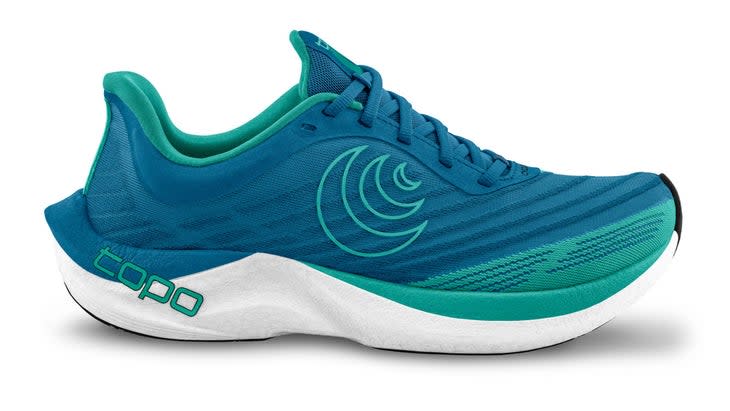
Weight: 6.9 oz (men's), 5.5 oz (women's)
Stack Height: 28-23 mm
Sizes: 8-12 (men’s), 6-11 (women’s)
Drop: 5 mm
Strengths: Comfortable cushioning with an ultralight, flexible, close-to-the-ground feel
Weaknesses: Too minimal for some
For some runners, today's supershoes feel overbuilt--the plate's too stiff, the midsole too tipsy, and the rocker too aggressive. The Topo Cyclone 2 presents an alternative formula, combining today's cutting-edge foam technology with a simplified, minimalist underfoot experience. One tester described the Cyclone as "a shoe that moves like a minimalist model and provides a stable, proprioceptive ground connection while cushioning and bouncing like a supershoe." Despite the low, flexible, minimalist feeling, the midsole still provides plenty of cushioning underfoot for effective shock absorption. Even one tester who favors thick-soled, stiff, maximum-cushioned shoes appreciated the lightness and high-energy rebound provided by the full Pebax midsole. Sitting atop the super-powered sole is a thin, airy, engineered mesh upper that's tailored for a secure midfoot wrap and a wide anatomical toe box. "The fit is comfortably snug and welcoming at 5k pace or slower," praised one tester, who also noted, however, that he found the wide forefoot felt slightly "sloppy" as he approached top-end speeds. One tester summed up: "The Cyclone 2 is a lightweight speed and race-day shoe that lets your foot control the shoe, not--like with so many of today's carbon-fiber super shoes--the other way around." Read our full review on the Topo Cyclone 2.
Best for Smooth Cruising: Adidas Ultraboost Light ($190)
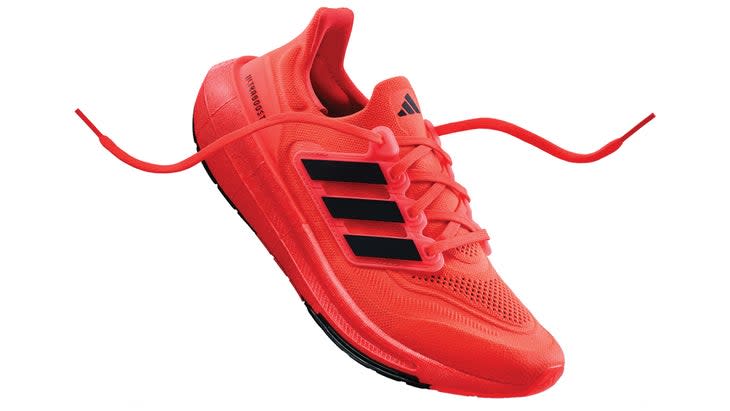
Weight: 10.5 oz (men's), 9.2 oz (women's)
Stack Height: 32-22 mm
Drop: 10 mm
Sizes: 4-18 (men’s), 5-11 (women’s)
Strengths: All the Boost bounce at a lighter weight; snug, supportive fit
Weaknesses: High heel felt obtrusive to some
The Adidas Ultraboost Light embodies everything we've come to love about the Ultraboost franchise--a soft, sock-like upper combined with a thick, luxurious slab of Adidas's smoothly responsive cushioning--at a fraction of previous models' heft. Credit Boost Light, a new foam formulation that weighs 30 percent less and gives four percent more bounce than the original Boost, while producing ten percent fewer carbon emissions in its production. On the road, we confirmed that the new midsole feels noticeably livelier than the foam in previous Ultraboosts. One tester noted, "There's still a ton of cushioning, but it feels light and responsive." Outside the new midsole, the airy knit upper remains essentially the same, with a snug, stretchy booty locked down with plastic midfoot overlays. The best part--there's no price difference between the original and this new lighter version.
Best for Comfort Junkies: Asics Gel-Nimbus 25 ($160)
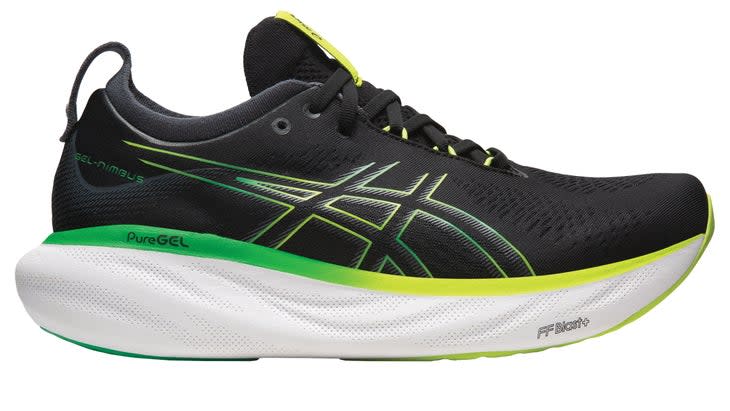
Weight:10.3 oz (men's); 9.1 oz (women's)
Stack Height: 41.5-33.5 mm (men's); 40.5-32.5 (women's)
Drop: 8 mm
Sizes: 6-16 (men’s), 5-13 (women’s)
Strengths: Plush from top to bottom; superior cushioning without feeling squishy
Weaknesses: Upper is a bit thick and heavy for a performance shoe
For its 25th birthday, Asics' franchise cushioned shoe lost its traditional, visible gel pod under the forefoot, and we don't miss it. The new EVA-blend foam in the Nimbus 25 is light, soft, and springy--and there's plenty of it, as the shoe got a 20 percent increase in overall stack height. But it's not overly squishy. "I especially like its bounce-back energy return," said a tester. A flat, oval-shaped chunk of the company's new gel (said to be softer and lighter than their previous formulations) sits within the foam under the heel and adds to the plush landing, while a late, steep rocker speeds toe-offs. Combined with the stretchy knit upper and well-padded heel collar, the new Nimbus delivers a supremely comfortable ride, ideal for high-mileage training, recovery runs, or just a soft, coddled feeling on daily outings.
Best for Longer Races: Saucony Endorphin Elite ($275)
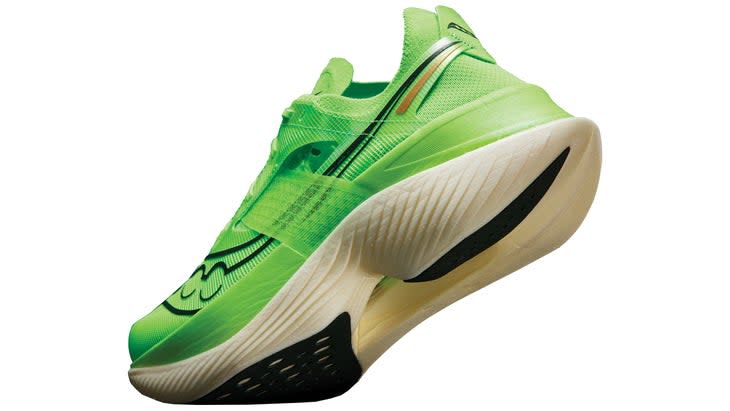
Weight: 7.2 oz (men's), 6.5 oz (women's)
Stack Height: 39.5-31.5 mm
Drop: 8 mm
Sizes: 7-15 (men's), 5-12 (women’s)
Strengths: Phenomenal bounce; quick-rolling ride
Weaknesses: Not as cushioned as some competitive super shoes
The all-new Endorphin Elite features a brand-new supercritical PEBA-based midsole called PWRRUN HG that Saucony claims is its most energy-efficient foam to date. The new midsole felt a tad firmer than the foam found in other Saucony supershoes, with one tester describing it as "well-cushioned but not overly soft." A little extra downward force, however, revealed its phenomenal energy return, and, with a slight step on the gas, testers said their stride fell into a powerful, rhythmic cadence that felt effortless. The full-length carbon fiber-plate embedded in the foam is forked to allow flex as the foot rolls inward, while its sharp upward curve under the toes creates a smooth, stable ramp for takeoff. "The foam and plate seemed to encourage and enhance a quick turnover," said one tester. The upper may look funky, but the combo of a soft, stretchy inner sleeve and an external webbing that wraps around the midfoot and beneath the carbon plate cinched testers' feet comfortably and securely, like the cockpit of an F-16 fighter jet.
Best for Nimble Versatility: Brooks Levitate 6 ($150)
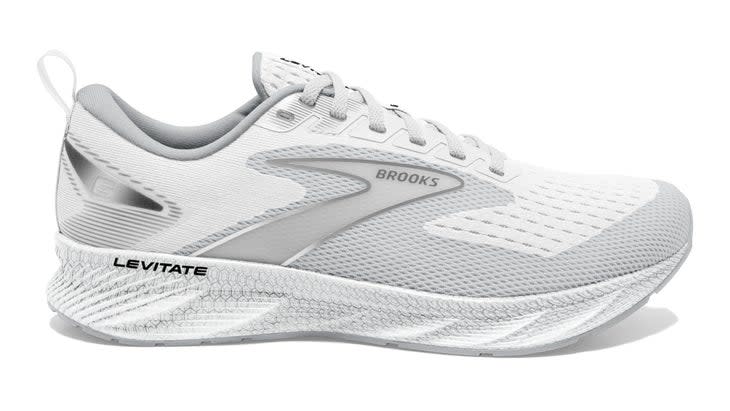
Weight: 10.9 oz (men's), 9.8 oz (women's)
Stack Height: 33.5-25.5 mm
Drop: 8 mm
Sizes: 7-15 (men’s), 5-12 (women’s)
Strengths: Sleek and quick-feeling, with a balance of cush and bounce
Weaknesses: Not as plush and overtly comfy as many cushioned models
This is the kind of shoe you wear day-in and day-out without having to decide what to put on. It's comfortable on long, slow miles, but ready and capable to pick up the pace when you are. The polyurethane-based midsole foam, called DNA AMP v2, is 10 percent lighter than the original and emphasizes bounce over cush. Testers described the ride as "responsive," "light," and "springy." One even said she felt "energized upon each step." A wider midfoot platform, arrow-point grooves on the outsole, and what seemed like just the right amount of forefoot cushioning encouraged smooth transitions from touch-down to toe-off. It's not the lightest shoe in this roundup, but it doesn't feel heavy. On the contrary, the Levitate 6 (unlike early versions) made our feet feel quick and nimble. Bonus: The updated fit works for a range of foot shapes
Most Forgiving: Nike Invincible 3 ($180)
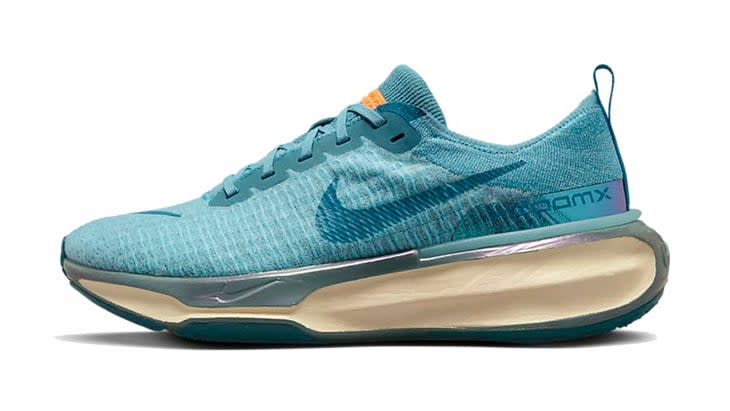
Weight: 10.9 ounces (men's), 9.1 ounces (women's)
Stack Height: 40-31 mm
Drop: 9 mm
Sizes: 6-15 (men's), 5-12 (women's)
Strengths: Unparalleled cushion-to-weight ratio; Uber-forgiving without being mushy or unstable
Weaknesses: Sluggish at speed
The bottom of Nike's product info page for the Invincible 3 reads like something their lawyers made them post: "Not intended for use as Personal Protective Equipment." That's right, the company doesn't want you to mistake this oversized shoe for a life preserver. Seriously, Nike appears to be avoiding any claims that the shoes are a protective medical device--and rightfully so, given the scant evidence linking any running shoe attribute to injury prevention. However, the Invincible's maximum cushioning--a full 40 mm of Pebax-based Nike ZoomX superfoam--absorbs the impact of each footfall and delivers a remarkably comfortable and forgiving ride. Yet it's not a mushy cush; the ZoomX feels both energetic and gently supportive. The springy foam has a rockered shape, which seems to create a smooth toe-off and helps even fatigued runners propel forward.
A super-wide platform that flares out under the forefoot and tapers uniquely toward the toe and arch, and a firm plastic clip surrounding the base of the heel, together help guide feet toward a natural, supported stride without trying to control. For so much shoe, the Invincible 3 is fairly lightweight. We reached for the Invincible 3 while ramping up mileage, and for days where we just needed a little extra love--like after doing a crap-ton of squats. Read our full review on the Nike Invincible 3.
Best Cushy Uptempo Shoe: On Cloudsurfer ($160)
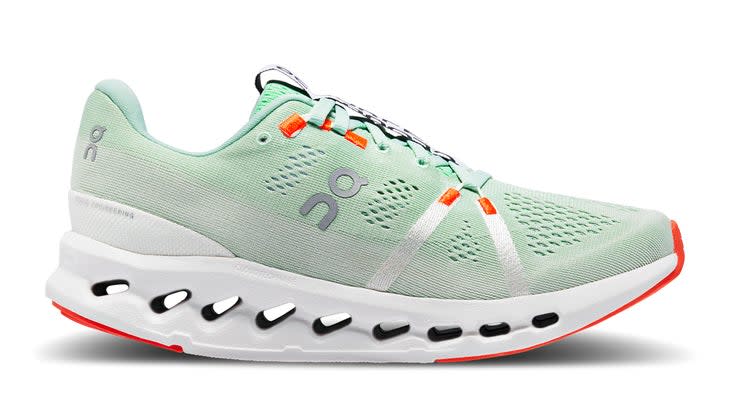
Weight: 8.6 oz (men's), 7.2 oz (women's)
Stack Height: 32-22 mm
Drop: 10 mm
Sizes: 7-14 (men’s), 5-11 (women’s)
Strengths: Soft, lively, smooth and comfortable ride; plush upper
Weaknesses: Cloudsurfer fans will miss the responsive, proprioceptive feel of previous versions
Some shoe updates are small, others so large they completely alter a shoe. The new Cloudsurfer falls into the latter category. In a radical departure from the external cushioning pods linked by a flexible Speedboard plate that has defined On's DNA, the new Cloudsurfer introduces a new era in Cloud cushioning technology called CloudTec Phase. The "clouds" are now holes carved through the uber-soft midsole, angled like a string of falling dominos to allow the midsole to collapse as you move forward. The resulting ride is "soft, lively, and unbelievably comfortable," said one previous On skeptic. Testers who have typically shied away from On running shoes for their stiff foam and firm underfoot feel absolutely raved about the new Cloudsurfer. However, our long-time Cloudsurfer loyalist missed the more stable, proprioceptive, and responsive ride of the original design. The new Cloudsurfer runs with a sense of freedom, plushness, bounciness, and flexibility that previous generations bound to the Speedboard platform could not. The heavily padded, soft mesh upper and tongue impressed our testers so much that one was inspired to run sockless. For those who prefer a lazyboy-soft ride and a flexible platform that moves with the foot, this is a fantastic lightweight, cushioned daily trainer, with enough pick-up-and-go for tempos and races.
Selecting a Road Shoe
If you're looking for a road shoe, consider if you want a speedster or something that feels good on long, slow jogs. Do you like the feel of a soft, forgiving ride, a more bouncy, energetic sensation underfoot, or a firmer platform that provides more groundfeel? Given new foams and technologies, many shoes today provide cushioning without sacrificing responsiveness or stability. Each balances these characteristics differently, however, creating a spectrum of options. Feel free to choose from any part of the menu.
How to Choose the Best Running Shoes for You
Fit and Feel
Choosing the best running shoes for is a matter of finding the models that fit your foot and feel best when you're running. To determine fit and feel, there's no substitute for trying the shoes on and running in them.
Fit: Match Your Foot Shape
When assessing fit, first pay attention to length. You need room at the end of your toes as your feet lengthen during their dynamic movements on the run. A rule of thumb is to allow a thumb's width between your longest toe and the end of the shoe. Runners often wear a running shoe a half or full size bigger than their street shoes.
Ensure that the shape of the sole and the upper matches your foot shape. The sole should be as wide or wider than your foot for the whole length, and match the curve of your arch comfortably. The shoe should hold your foot securely over the instep, while allowing the ball of the foot and the toes to splay and flex when you roll forward onto them. Your heel shouldn't slip when you lift it, and the arch should be able to dome and lengthen naturally. Nothing should bind or rub as you roll through the stride.
Feel: Match Your Movement Path
If the shoe fits, it's time to take them on a short run on a treadmill, around the store, or, ideally, down the block and back. Every running shoe has a unique ride created by the type and density of foam(s) in the midsole and the geometry of that foam: its thickness, width, heel-to-toe drop, and forefoot flexibility or rocker shape. Each of these elements interact with each other and your stride to determine how the shoe reacts on landing, how much it cushions, how stably it supports, how smoothly it transitions from landing to toe off, and how quickly and powerfully it rebounds.
The best way to choose the shoes that complement your body and stride is to find the ones that feel right on the run. Benno Nigg, the world-leading biomechanics professor who proposed this method of shoe selection, calls it the "comfort filter," but makes clear it is far more than how plush the shoe feels when you step into it. What you want to assess is whether the shoe allows and supports the way your feet want to move, what Nigg calls your "preferred movement path." In the right shoe, while running at your normal pace, you will touch down where you expect to land, roll smoothly and stably through the stride without noticing the shoe, feel both cushioned from and connected to the ground, and push off naturally, quickly, and powerfully. When this comes together you'll know that you've found your pair.
It's likely that several shoes will feel good on your feet. To find the most comfortable, it helps to compare them back to back, like an eye doctor will do with corrective lenses: flipping between "A" or "B," "1" or "2." You may also find that different shoes feel better at different paces or level of fatigue, and you may want more than one pair. In fact, research shows that wearing a variety of different shoes is one of the few proven ways to reduce injury risk as it appears to vary the stresses on your feet and joints.
What About Injury Prevention?
Running shoes have long been marketed and sold as prescriptive devices to help runners stay healthy, but there is little scientific evidence correlating shoes, or any specific shoe properties--like cushioning or pronation control--with running injuries. Medical professionals say that it is highly difficult to determine whether a runner needs a certain type of shoe, and studies have shown that prescribing shoes with traditional methods like treadmill gait analyses or wet-foot arch height tests don't consistently reduce injuries.
Don't assume that you need more cushioning or more stability if you have sore joints, or if you're a heavier runner, or if you're a beginner--evidence doesn't support many common beliefs. The best way to prevent injury is to find two or three different pairs that feel right on the run, ease into using them, and vary your shoes, your running surface and your pace regularly (plus avoid rapid increases in your training load).
How We Test
Testing Stats
Number of testers: 27
Number of shoes tested: 72
Number of miles: 9300+ over four months
To test running shoes, we begin by researching every brand's upcoming offerings for the coming season. We wind up with dozens of samples of the models (70 this season) that are most promising--not just for us, but for 25 testers that range in age, ability, running form, geographical location, terrain, and preferred shoe types. We try to put each tester in models from within the same category (all rugged, backcountry trail shoes, or all road-to-trail crossovers) so everyone can test apples-to-apples.
After three to six months of running in each model on varied terrain and in all conditions, our crew members report back with their assessments of fit, comfort, traction, cushioning, flexibility, stiffness, pop, what type of running the model is best used for, how the shoe compares to other models, and more. We also run in every shoe ourselves, and, combining all the tester feedback with years of personal experience, hone in on the best.
Meet Our Lead Testers
Cory Smith
Cory's passion for running started over 25 years ago in high school when he became the number six ranked runner in the nation at 3000 meters his senior year. After high school, he competed at Villanova University, earning two NCAA Division I Championship showings. Today, he's determined not to let age slow him down and competes on the national master's circuit, running a 4:12 (4:30 mile pace)) 1500 meters and 9:04 (4:52 mile pace) 3000 meters in 2021 at age 43. He prefers a hard track workout or tempo run over an easy long run any day but also appreciates a challenging trail or mountain run. His obsession with running shoes started in 2014 when he wrote his first shoe review for Gear Institute. Since then, he's tested and reviewed hundreds of running shoes, clothing, and gear for Outside, Runner's World, Footwear News, and other outlets. He has a soft spot for speedy shoes over heavy trainers but loves dissecting all shoes equally and thinking like a product engineer to explain the why behind every design detail. Cory is the Founder of Run Your Personal Best, an online running coaching business, and since its inception in 2014, has coached runners' to over 100 Boston Marathon Qualifying times.
Lisa Jhung
Freelance journalist, editor, and author Lisa Jhung has researched, tested, and written about running shoes for the past decade and a half, much of that time for Outside and Outside Buyer's Guides. She coordinates a fleet of female shoe testers out of Boulder, Colorado, and says her home office is a perpetual obstacle course of cardboard boxes and piles of running shoes. Lisa's written about gear of all kinds for numerous national magazines as both an editor and freelancer, including a stint as the Shoes & Gear blogger and trail running microsite editor for Runner's World. A high school jumper and occasional sprinter/hurdler, she started running--really running--after walking off the collegiate volleyball team, and moved on to road and trail races of any distance, triathlons, adventure races, and mountain running. She's happiest testing rugged trail shoes on gnarly terrain, and also loves a good neighborhood jaunt…but is almost always looking for ribbons of dirt. Lisa is the author of "Running That Doesn't Suck: How to Love Running (Even If You Think You Hate It)" (2019) and "Trailhead: The Dirt on All Things Trail Running" (2015).
Jonathan Beverly
Jonathan fell in love with running his freshman year of high school and quickly became fascinated with finding the perfect pair of running shoes. That quest got a boost when he became editor of Running Times in 2000 and started receiving every new model as they were released. The parade of shoes continued while he served as shoe editor for Runner's World, then editor of PodiumRunner, and currently running gear editor at Outside. Having now worn nearly every running shoe created in this century--and a fair amount of those dating back to the early running models of the late 70s--he's given up on finding the one best and now relishes the wide variety of excellent options. Once a 2:46 marathoner regularly doing 50+ mile weeks, recent injuries and his age (58) have reduced his volume by about half and slowed his easy training pace to around nine-minute miles--but he says he still enjoys an uptempo workout or two each week. Beverly wrote the book Your Best Stride in 2017, which explored how each individual's gait--and thus shoe preference--is unique. He enjoys getting biomechanical researcher's take on new shoe trends, and, as a tester, trying to describe the nuances of each shoe's ride.
For exclusive access to all of our fitness, gear, adventure, and travel stories, plus discounts on trips, events, and gear, sign up for Outside+ today.

